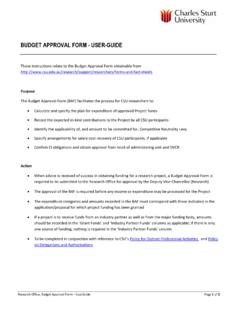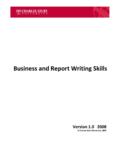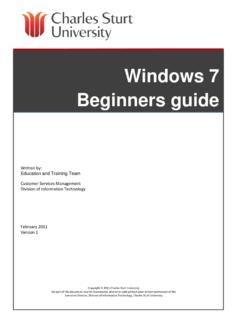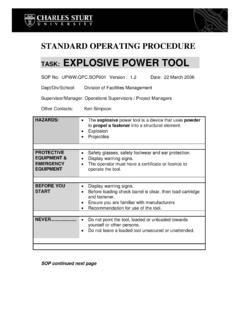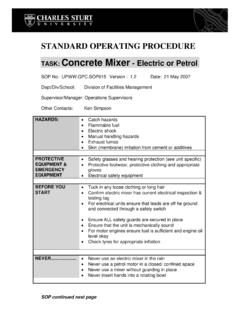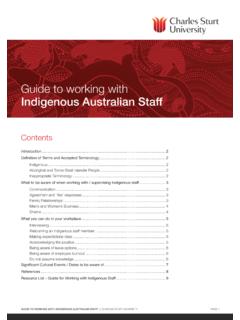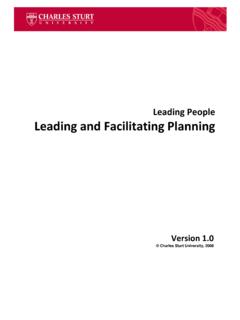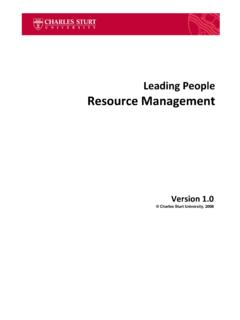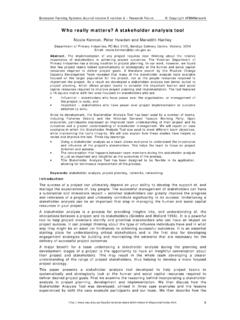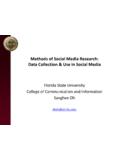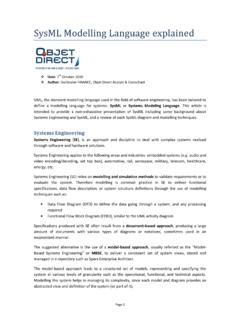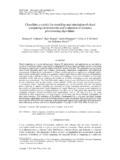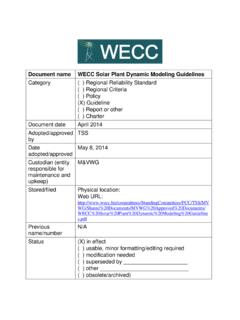Transcription of ARIS Standards and Conventions Manual
1 CSU Enterprise Workflow Project (EWP) Phase 1. ARIS Standards and Conventions Manual Date: 23 June 2014. Version: software AG. ARIS Modelling Standards and Conventions Manual 17 June 2014. Document Control Document History Date Version Authors Comments/Description of Change 10-Jun-2014 Luke Audie Initial Version for Client review 13-Jun-2014 Luke Audie Changes incorporating review comments 17-Jun-2014 Luke Audie Further Changes based on discussions with CSU. 23-Jun-2014 Luke Audie Further Changes based on CSU feedback received 23-Jun-2014 Bruce Crawford release based on approval of draft. Reviewers Organization Role Name Review Date software AG Project Manager Raviprasad S Cadambi 06-Jun-2014. Project Manager and BPM. CSU IT Team Lead Bruce Crawford 19/06/2014. CSU Business Business Analyst Sophie Dewar 19/06/2014. CSU IT Team Business Analyst Marian Wolmarans 19/06/2014. CSU IT Team System Administrator Scott Barlow 19/06/2014.
2 Approvers Organization Role Name Date Director, Enterprise CSU IT Team Diane Ireland 25/06/2014. Architecture Geoff Honey CSU Steering Project Sponsor (Executive Director, Division of N/A. Committee Student Administration). 2014 software AG. All rights reserved. Page 2 of 57. ARIS Modelling Standards and Conventions Manual 17 June 2014. Table of Contents Introduction 7. Purpose 7. Intended Audience 7. Background 7. Conventions Definition 7. Why Adopt a Common Approach to Conventions ? 8. 1 ARIS Overview 9. ARIS Methodology 9. ARIS Framework / Views 9. 2 ARIS Database Framework 10. Database Naming Conventions 10. Database Folder Structure 11. Artefact Libraries 12. Definition and Occurrence Objects 12. User Access and Authorisation 13. 2 ARIS Modelling Design Standards 16. Filter 16. Template 17. Basic ARIS Client settings 18. 3 ARIS Governance 19. Content Release Cycle Management 19. Modelling Governance Process 20. Change Request and Assessment 20.
3 Model Design 21. Audit Trail 21. 4 Model-to-Execute 22. 5 CSU Enterprise Framework 23. Navigation / Entry Models 23. CSU Entry Model 23. Project Entry Model 24. Organisational Modelling 25. Process Modelling 26. Value-added Chain Diagram (Level 1 and 2) 27. 2014 software AG. All rights reserved. Page 3 of 57. ARIS Modelling Standards and Conventions Manual 17 June 2014. BPMN Collaboration Diagram (Levels 3 5) 28. Function Allocation Diagram (Supporting all levels) 30. Information Modelling 33. Level 1 - IE Data Model (Business Objects) 33. Level 2 - IE Data Model (Entities) 34. Level 3 - eERM Attribute Allocation Diagram (Attributes) 34. Application Modelling 36. Application Domain Model 36. Application Communication Model / Interfaces 37. Application Screens 39. Report Catalogue 42. Project Requirements Modelling 43. Capability and Service Modelling 43. Business Capability Model 43. Business Service Model 44. Common Attributes 48.
4 Common Model Attributes 48. Common Object Attributes 49. 3 Modelling Standards 50. General Modelling Guidelines 50. BPMN Modelling Guidelines 51. Model and Object Naming 51. Model Naming 51. 4 ARIS Reports and Macros 54. Standard Reports and Macros 54. Custom Reports and Macros 55. ARIS Competency Centre (Proposed Future State) 56. 5 Glossary 57. 2014 software AG. All rights reserved. Page 4 of 57. ARIS Modelling Standards and Conventions Manual 17 June 2014. Table of Figures Figure 1: CSU Process Hierarchy 9. Figure 2: ARIS House representing the Views of an Organisation 9. Figure 3: CSU Enterprise Repository Folder Structure 11. Figure 4: Example Library Folder Structure 12. Figure 5: Occurrence Copy Illustration 13. Figure 6: ARIS Identifiers 13. Figure 7: Example Folder Permissions 14. Figure 8: User Groups Defined in Central User Management 15. Figure 9: Example Attributes Maintained in Standards DB 16. Figure 10: Steps to Update CSU Filter 16.
5 Figure 11: CSU Modelling Template 17. Figure 12: CSU Header Model Location 17. Figure 13: CSU Header 17. Figure 14: Model Status List 19. Figure 15: Object Status List 19. Figure 16: Model Design Governance Process 20. Figure 17: Change Request and Assessment Process 20. Figure 18: Governance Process for Controlling Modelling Activities 21. Figure 19: Changes Stored in Model Attributes 21. Figure 20: Documenting Process Design 21. Figure 21: Model-to-Execute Lifecycle 22. Figure 22: CSU Entry Model 23. Figure 23: Example Organisation Chart 25. Figure 24: CSU Process Hierarchy 26. Figure 25: Example Level 1 Enterprise Map Diagram 27. Figure 26: Example Level 2 Main Process Diagram 27. Figure 27: Example Level 3 BPMN Diagram 28. Figure 28: Example Level 4 / 5 BPMN Diagram 28. Figure 29: BPMN Connection Attributes 30. Figure 30: Example Level 2 4 Process FAD 31. Figure 31: Example Manual Task FAD Diagram 31. 2014 software AG. All rights reserved.
6 Page 5 of 57. ARIS Modelling Standards and Conventions Manual 17 June 2014. Figure 32: Example Automated Task FAD Diagram 31. Figure 33: Example User Task FAD Diagram 32. Figure 34: Example Level 1 - IE Data Model (Business Objects) Diagram 33. Figure 35: Example Level 2 - IE Data Model (Entities) Diagram 34. Figure 36: Level 3 Example eERM Attribute Allocation Diagram (Attributes) 35. Figure 37: Example Level 1 - Application Domains Diagram 36. Figure 38: Level 2 - Example Application Modules Diagram 37. Figure 39: Example Level 1 - Overall Interface Diagram 38. Figure 40: Example Level 2 - Interface Description Diagram 38. Figure 41: Example Level 1 - Screen Catalogue Diagram 39. Figure 42: Example Level 2 - Screen Design Diagram 40. Figure 43: Example Level 2 - Screen Diagram 41. Figure 44: Example Report Catalogue Diagram 42. Figure 45: Example Project Requirements Diagram 43. Figure 46: Example Business Capability Model 44.
7 Figure 47: Example Level 1 - Enterprise Business Service Map 44. Figure 48: Example Level 2 Business Service Allocation 45. Figure 49: Example Level 1 - Enterprise software Service Map 46. Figure 50: Example Level 2 software Service Allocation 47. Figure 51: Hiding ARIS Reports 54. Figure 52: ARIS Competency Centre 56. 2014 software AG. All rights reserved. Page 6 of 57. ARIS Modelling Standards and Conventions Manual 17 June 2014. Introduction Purpose This Manual is designed to provide guidance in the use of Conventions for creating and describing CSU's Enterprise Model including; process, application, technology, information, service, organisational and requirement models using the ARIS toolset and assumes the audience has had prior training before reading this Manual . The reader will note that process design is emphasised in this Manual , but the solution also provides an approach and methodology for enterprise architecture management, work flow, and application processing.
8 Intended Audience This guide is intended as a key reference for those using the ARIS tool-set to support the review, modelling, analysis, design and in general, improvement of content, within the ARIS Enterprise Repository, as part of defined projects or discrete assignments. It is also intended for those specifically involved in developing and maintaining defined architectural models. In the main it is expected that the primary users of this Manual will include: Business Analysts Process Owners Solution Architects / Process Engineers Process Developers Enterprise Architects Background The ARIS Enterprise Repository will provide an abstract view of the complex structures of the organisational processes and enterprise architectures. The diagrams within the repository are used to document, analyse, and communicate the state of how the organisation operates and the associated consumed resources. This requires a standard way of capturing the state of information in a manner that will enable different viewers of the diagrams to interpret it in the same way with minimal variations.
9 For this reason, ARIS mapping Conventions define the allowed elements and their meaning. Following prescribed modelling Conventions will allow for efficient, collaborative business process and enterprise architect management across CSU's boundaries and disciplines. Conventions Definition Conventions are a collection of elements, protocols and rules, which when applied consistently, result in a set of process and associated diagrams and documents constructed in a logical and standardised way. Business diagrams inform the user and the viewer about the contents and value of each document, and the usage of the document in a concise manner. Conventions assist users to achieve an efficient use and reuse of information while maximising understanding of information both within and outside each organisational unit. 2014 software AG. All rights reserved. Page 7 of 57. ARIS Modelling Standards and Conventions Manual 17 June 2014. Why Adopt a Common Approach to Conventions ?
10 A variety of Conventions are used for enterprise modelling. However, these are generally used in a non- uniform manner and are subject to wide interpretation. A shared understanding of the organisation will be developed through the use of a common language for depicting and describing processes. As CSU organisational users become more familiar with how their organisational information and processes are modelled using a standard modelling notation ( Conventions ), they will become better at articulating their knowledge. Not only will well described enterprise documentation greatly assist in identifying opportunities to business improvement, they also develop a shared understanding of processes and their performance. CSU organisation units applying Conventions to enterprise documentation will be provided with consistent, logical models and will be able to distinguish similar documents and process diagrams from one another at a glance.
